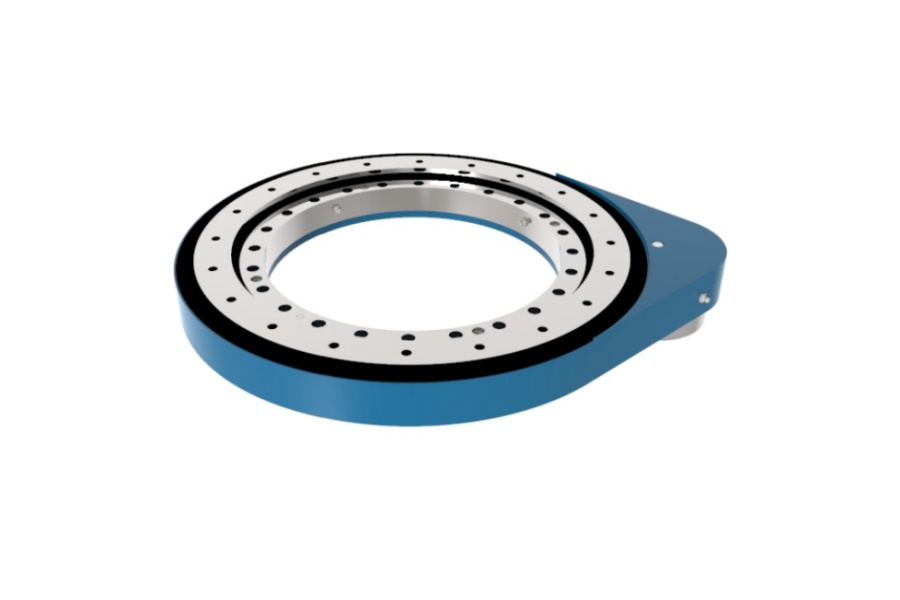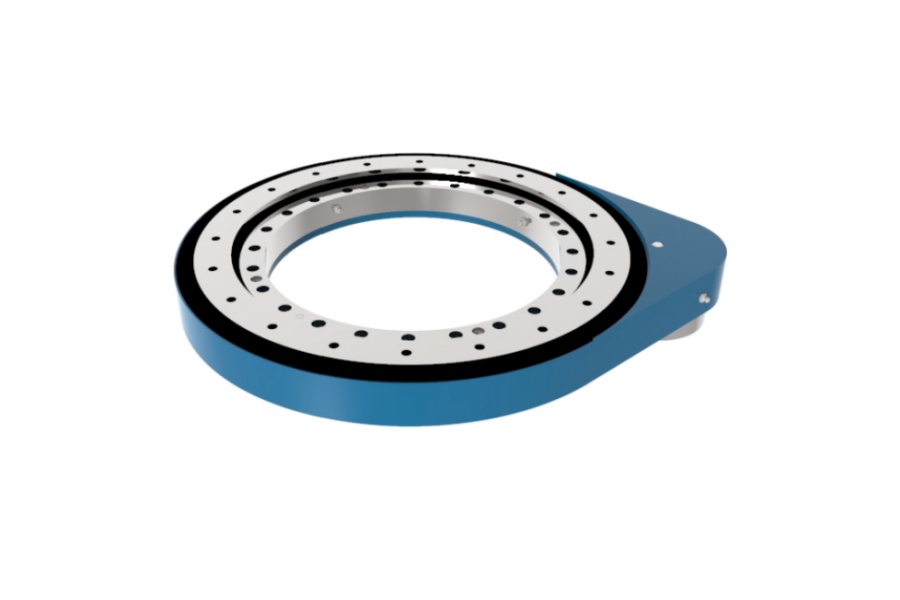
Core Rotation Component of Spur Gear Slew Drive
What is Spur Gear Slew Drive
Spur Gear Slew Drive is a fully integrated mechanical actuator system designed to provide controlled, high-torque rotational movement about a single axis. It represents a complete fusion of a robust drive motor (typically hydraulic or electric), a high-ratio speed reducer such as a worm gearbox, and a large-diameter slewing ring bearing with a spur (straight-cut) gear machined directly onto either its inner or outer ring. This integrated design distinguishes it from systems where these components are sourced and assembled separately. The primary function of a slew drive is to efficiently transform the high-speed, low-torque output of its input motor into a slow-speed, high-torque rotational output, enabling it to manage immense loads with precise control. The term "spur gear" specifically refers to the geometry of the gear teeth on the slewing ring; these teeth are straight and aligned parallel to the axis of rotation, which differentiates it from other drives using helical or bevel gears. This configuration is prized for its manufacturing simplicity, ease of installation and maintenance, and its ability to deliver high power transmission efficiency in a compact and robust package, making it a cornerstone component in heavy machinery where reliability under extreme stress is paramount.

Core Rotation Component of Spur Gear Slew Drive
The undisputed core rotational component of a spur gear slew drive is the slewing ring bearing, also commonly referred to as a slewing bearing or turntable bearing. This component is far more than a simple bearing; it is a complex, engineered structural element that serves as the fundamental mechanical interface between the stationary base and the rotating platform of a machine. Its primary role is to simultaneously support the complex combination of axial, radial, and moment (tilting) loads generated during operation while facilitating smooth and precise rotation, all within a single, compact unit. The slewing ring's integrated spur gear meshes directly with the output pinion of the drive's gearbox, transferring the generated torque into rotational force.
The anatomy of a standard slewing ring consists of several key elements. It features two robust steel rings—designated as the inner and outer rings—which are precision-machined with raceways. Between these rings are the rolling elements, which can be balls or cylindrical rollers. These elements are spaced and guided by separators or cages to ensure even load distribution and prevent friction. For a spur gear slew drive, a critical feature is the spur gear teeth, which are machined directly onto the periphery of either the inner or outer ring. The choice of gear location defines the drive's configuration: an external gear slew drive has teeth on the outer ring, while an internal gear slew drive has teeth machined on the inner ring. The selection depends on the specific mechanical design and load requirements of the application. Furthermore, advanced multi-lip sealing systems are integrated around the rings to form a vital barrier, protecting the precision-ground raceways and gear teeth from abrasive contaminants like dirt, dust, and moisture, thereby ensuring long-term reliability and consistent performance.
Within the context of a spur gear slew drive, the most commonly employed type of slewing ring is the single-row four-point contact ball design. This design is highly efficient and compact. A single row of balls is engineered to make contact with the raceways at four points, enabling the single bearing to handle all combinations of loads (axial, radial, and moment) simultaneously. This design offers an excellent balance of load capacity and rotational efficiency, making it ideal for a wide range of general industrial applications. However, for applications demanding higher precision and significantly greater load capacity—particularly higher axial loads and stiffening moments—a single-row crossed roller slewing ring is often utilized. In this design, cylindrical rollers are arranged in a single row in a crisscross pattern (oriented at 90 degrees to each other). This configuration provides a much larger contact area with the raceways compared to ball designs, resulting in superior rigidity, higher moment stiffness, and exceptional precision with minimal elastic deformation under load. The selection between a four-point contact ball bearing and a crossed roller bearing is a fundamental engineering decision based on the specific performance requirements of the slew drive's application.
Characteristics of Spur Gear Slew Drive
Spur Gear Slew Drives are defined by a distinct set of engineering characteristics that make them indispensable for high-torque, low-speed rotational applications. Their most defining feature is the exceptionally high torque output delivered in a compact and integrated package. By combining a high-ratio worm gear reducer with a large-diameter slewing ring, they achieve massive mechanical advantage, allowing relatively small input motors to control and move immensely heavy loads with precision. This integrated design eliminates the need for custom-designed mounting solutions for separate components, simplifying machine design, saving space, and reducing the overall number of parts in the system, which enhances reliability.
A key operational characteristic is their inherent self-locking capability when a worm gear reducer is employed. The design of the worm and worm wheel creates a high friction angle that prevents back-driving. This means that when the input drive stops, the load is immediately and reliably held in position without the need for an external braking system. This is a critical safety feature in applications like crane booms, solar trackers, or lifting platforms where maintaining a stationary position under load is absolutely essential. Furthermore, spur gear slew drives are renowned for their robustness and durability. They are constructed from high-strength, hardened steel alloys (e.g., 42CrMo4 for rings) and are designed to operate reliably under severe conditions, including exposure to heavy shock loads, vibrations, and harsh environmental elements, thanks to their protective sealing systems.
The use of a spur gear offers specific advantages. Compared to helical gears, spur gears are simpler to manufacture, inspect, and maintain. Their straightforward geometry allows for easier alignment during installation and meshing with the pinion. While they can be slightly noisier than helical gears at very high speeds, this is less of a concern in the slow-speed, high-torque applications where slew drives excel. Finally, these drives offer significant design flexibility. They can be configured with the gear on the inner or outer ring, sourced with different sealing and lubrication options for various environments, and customized with a range of input motors (electric, hydraulic) and gear reduction ratios to meet the exact torque and speed requirements of a specific application.
Applications of Spur Gear Slew Drive
The application of spur gear slew drives is extensive across industries that require robust, controlled, and powerful rotational movement. In the construction and heavy machinery sector, they are the fundamental actuation system in the boom rotation of mobile cranes, enabling precise positioning of heavy loads. They are also critical in concrete pump trucks for controlling the placement boom and in excavators for providing rotation in compact swing drives.
The renewable energy industry is a major and growing application field. Slew drives are the core component in solar tracking systems for both photovoltaic (PV) panels and concentrated solar power (CSP) systems. They provide the precise, powerful rotation needed to accurately angle solar arrays throughout the day, significantly increasing energy capture. Similarly, they are used in the yaw and pitch control systems of smaller wind turbines, adjusting the nacelle and blades to optimize performance.
In industrial automation and material handling, these drives are essential. They operate the rotating bases of robotic welding and assembly arms, provide motion for indexing tables on heavy-duty machining centers, and are found in rotary conveyors and palletizers. The mining and agricultural industries rely on them for robust performance in stackers, reclaimers, and heavy-duty tractors. Furthermore, their high precision and holding power make them suitable for specialized applications such as radar and satellite antenna positioning, medical imaging equipment like CT scanners, and even in deck cranes and winches on marine vessels.
Factors Influencing the Price of Spur Gear Slew Drive
The price of a spur gear slew drive is determined by a confluence of technical specifications, material choices, and commercial factors. The single largest cost driver is often the size and material of the core slewing ring. Larger diameters require more raw material and more complex machining processes. The grade of steel (e.g., standard 50Mn or high-strength 42CrMo4) and the extent of heat treatment (induction hardening) applied to the raceways and gear teeth significantly impact cost, as does the choice of rolling element (ball vs. more expensive crossed roller).
The level of customization and complexity is another major determinant. A standard, catalogued unit is more economical than a fully custom-designed drive. Customizations such as special gear specifications (module, precision grade), unique mounting hole patterns, specific seal materials for extreme temperatures, special surface coatings (e.g., anticorrosion treatments), and integrated sensors drastically increase manufacturing overhead. The specifications of the included components, namely the type and power of the input motor (standard electric motor vs. a customized hydraulic motor) and the design of the gear reducer, also form a significant portion of the total cost.
Performance requirements directly influence price. Drives manufactured to standard industrial tolerances are cost-effective. Those produced to ultra-precise, micron-level tolerances for applications like medical imaging or aerospace, which require 100% non-destructive testing (NDT), full material traceability, and extended performance validation, command a premium. Finally, order quantity and external factors play a role. Large volume orders benefit from economies of scale, reducing the unit cost. Global fluctuations in steel prices, international shipping costs, and import/export tariffs can also cause price variations.
Supplier of Spur Gear Slew Drive
For engineers seeking a reliable source for high-performance spur gear slew drives, LYRADRIVE stands as a manufacturer with deep expertise in the engineering and production of these integrated systems. The company provides comprehensive technical support, guiding customers through selection, installation, and maintenance best practices to ensure optimal performance and longevity. This support is backed by a rigorous quality management system governing every production stage, from material forging and precision gear hobbing to heat treatment, final assembly, and testing. By offering advanced manufacturing capabilities and a commitment to delivering robust and reliable drive solutions, LYRADRIVE has established itself as a trusted partner for a global clientele across diverse industries such as solar tracking, construction, and industrial automation.



